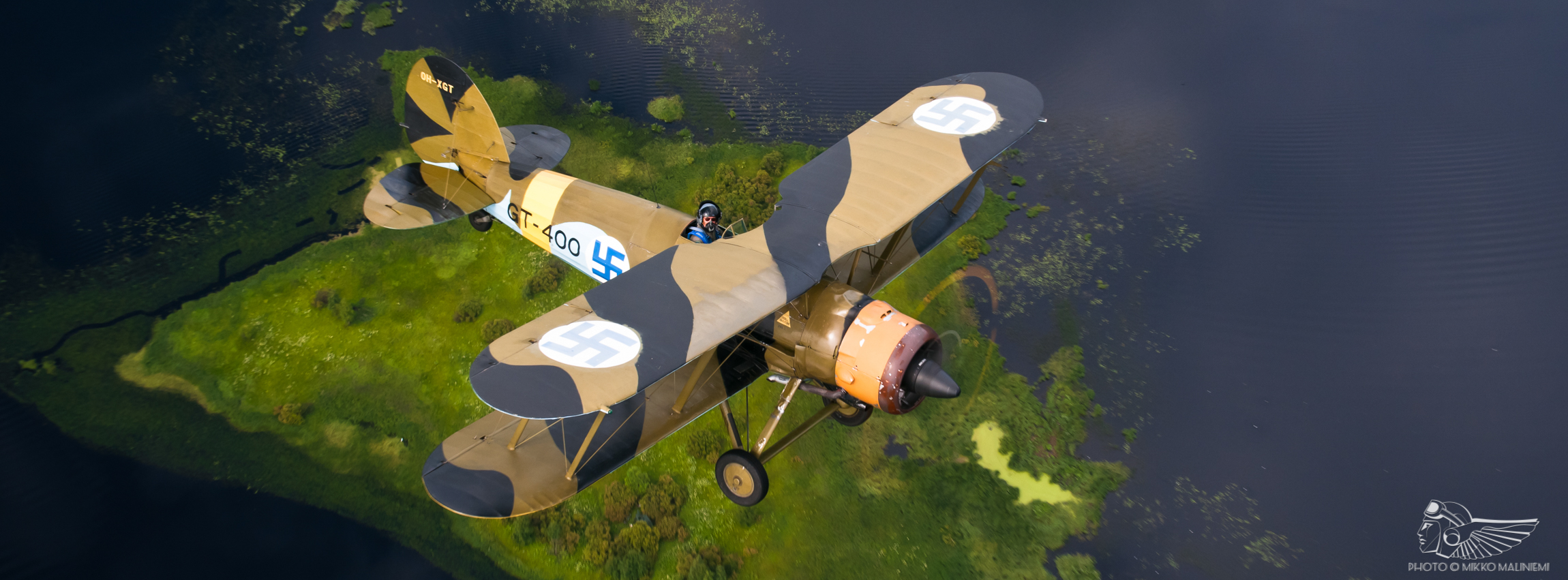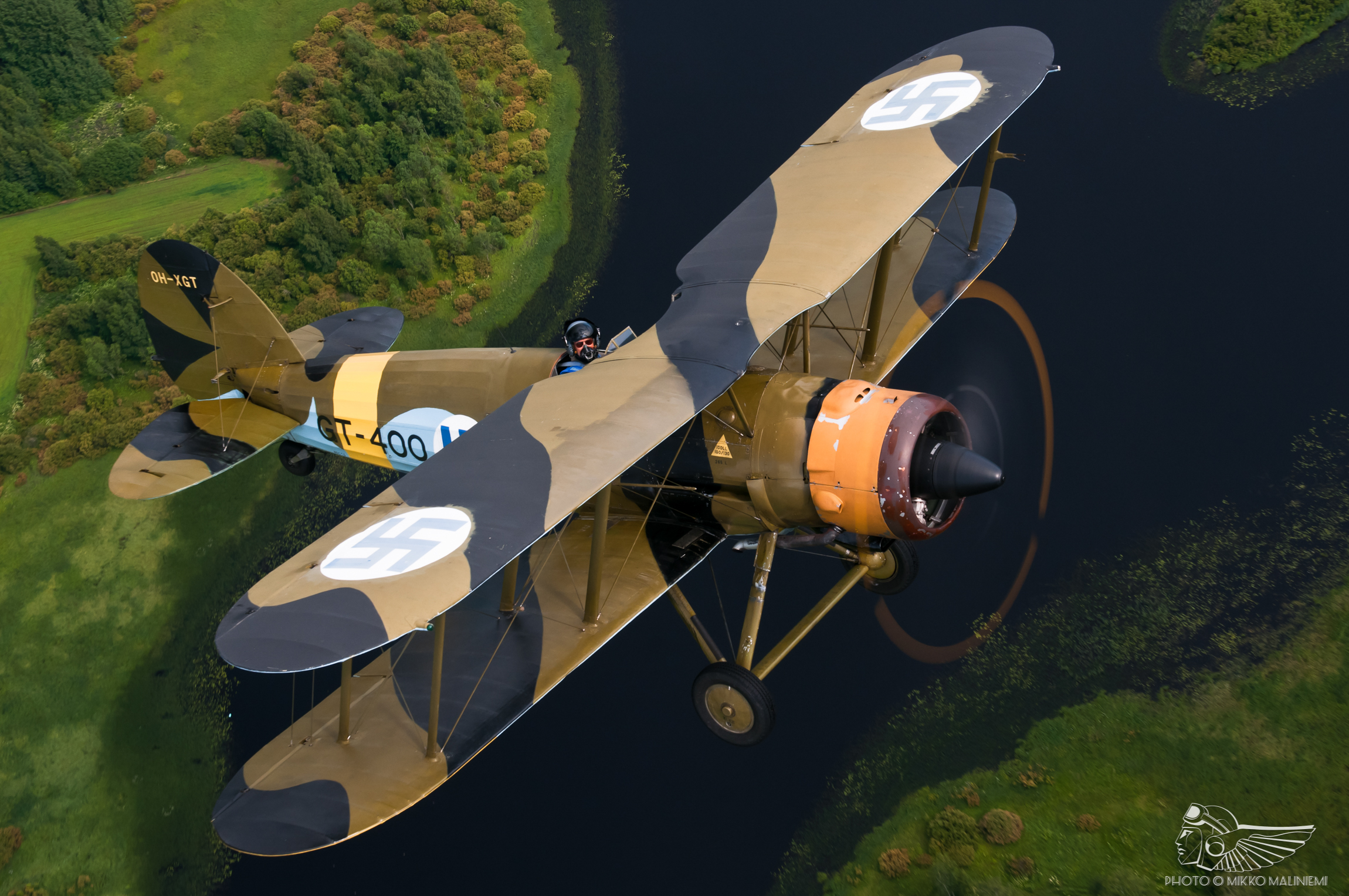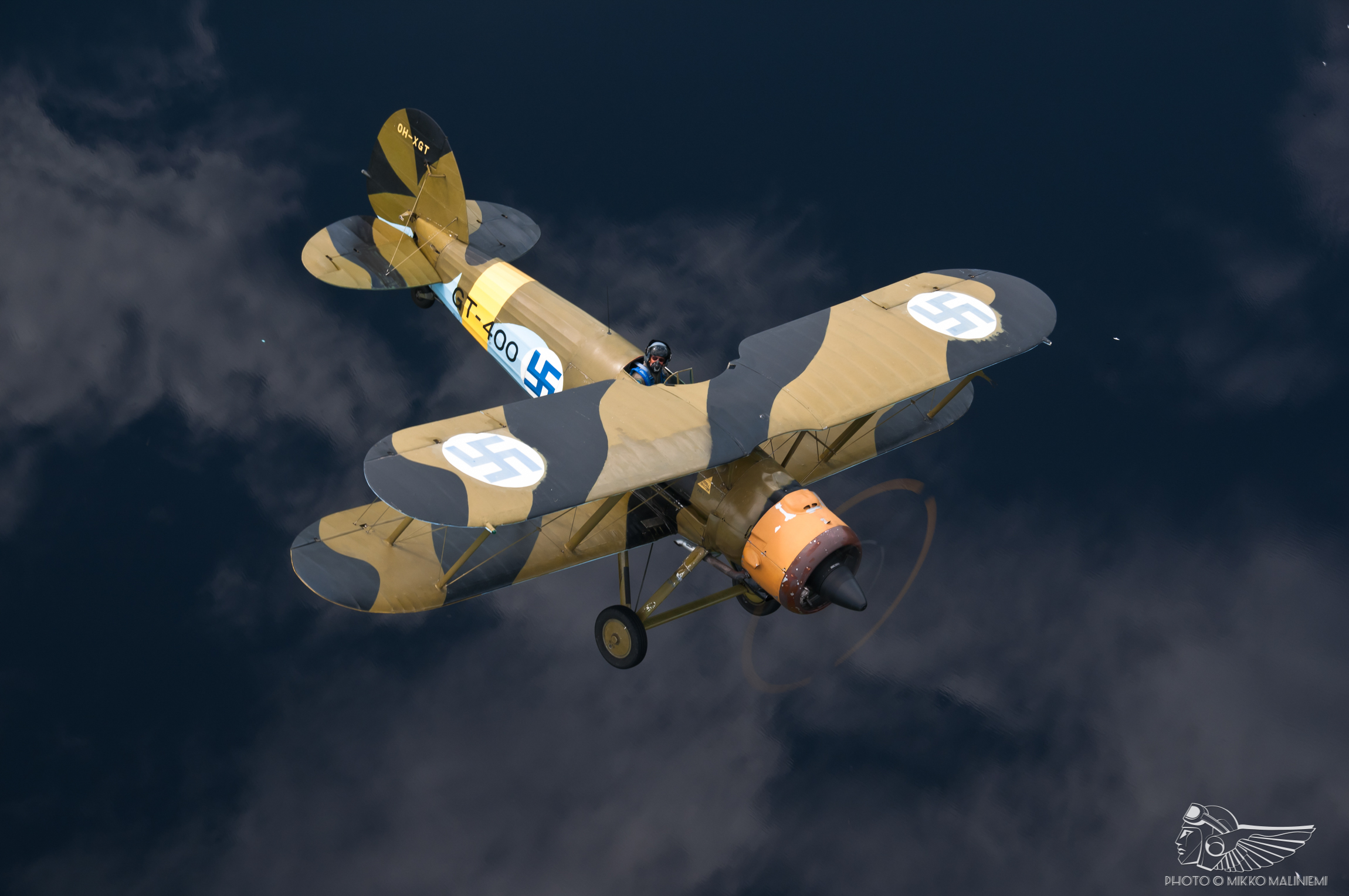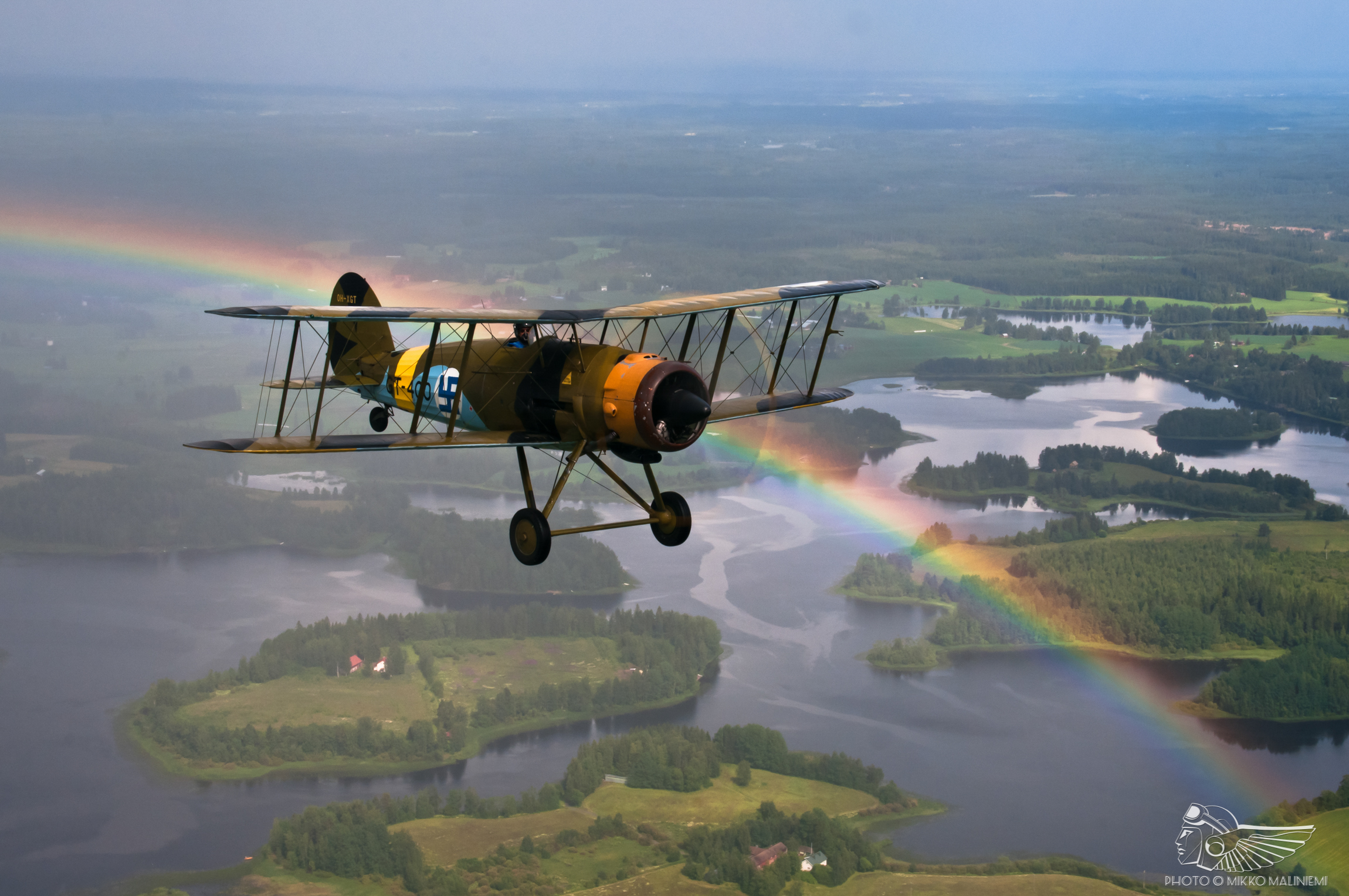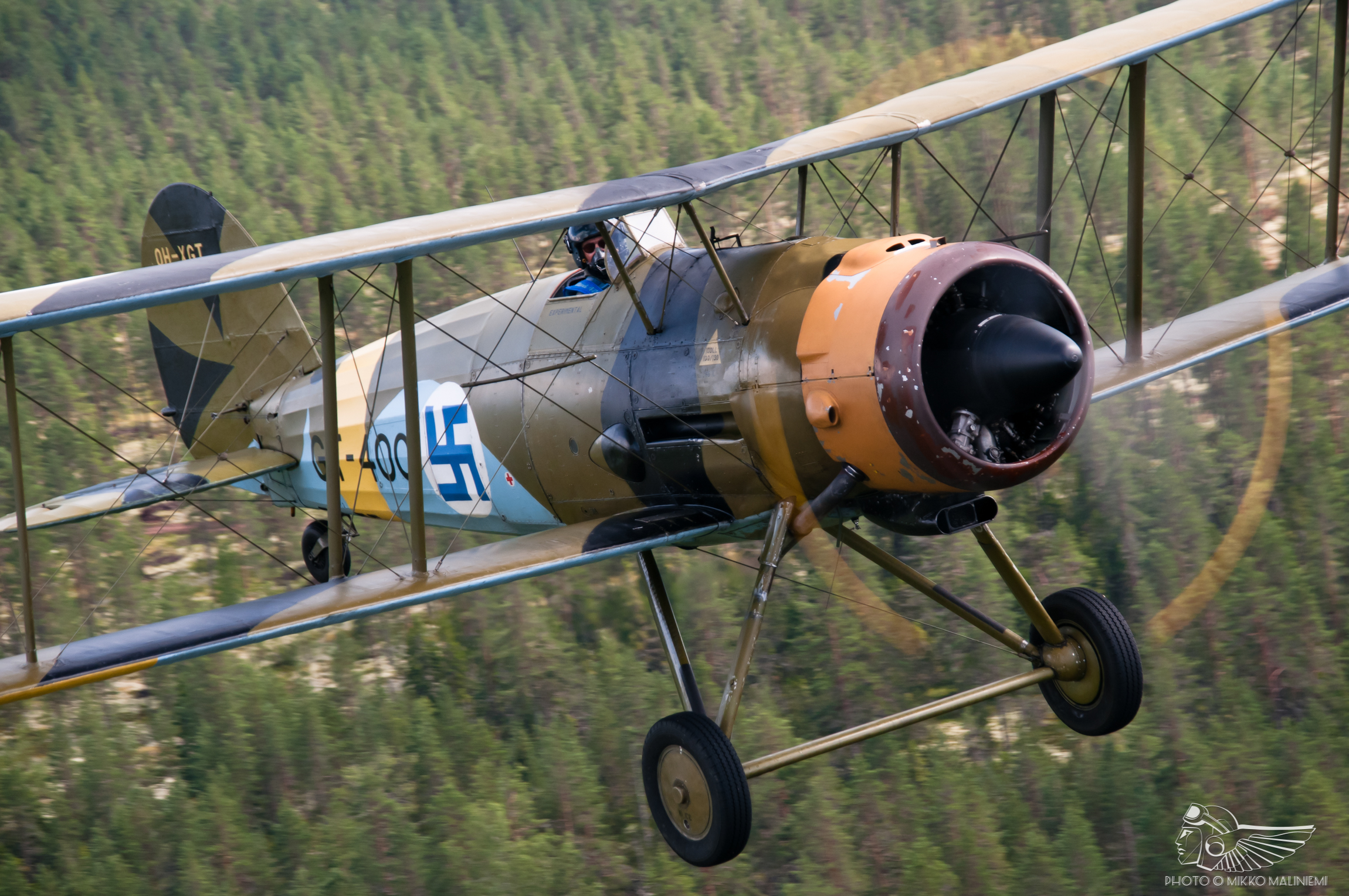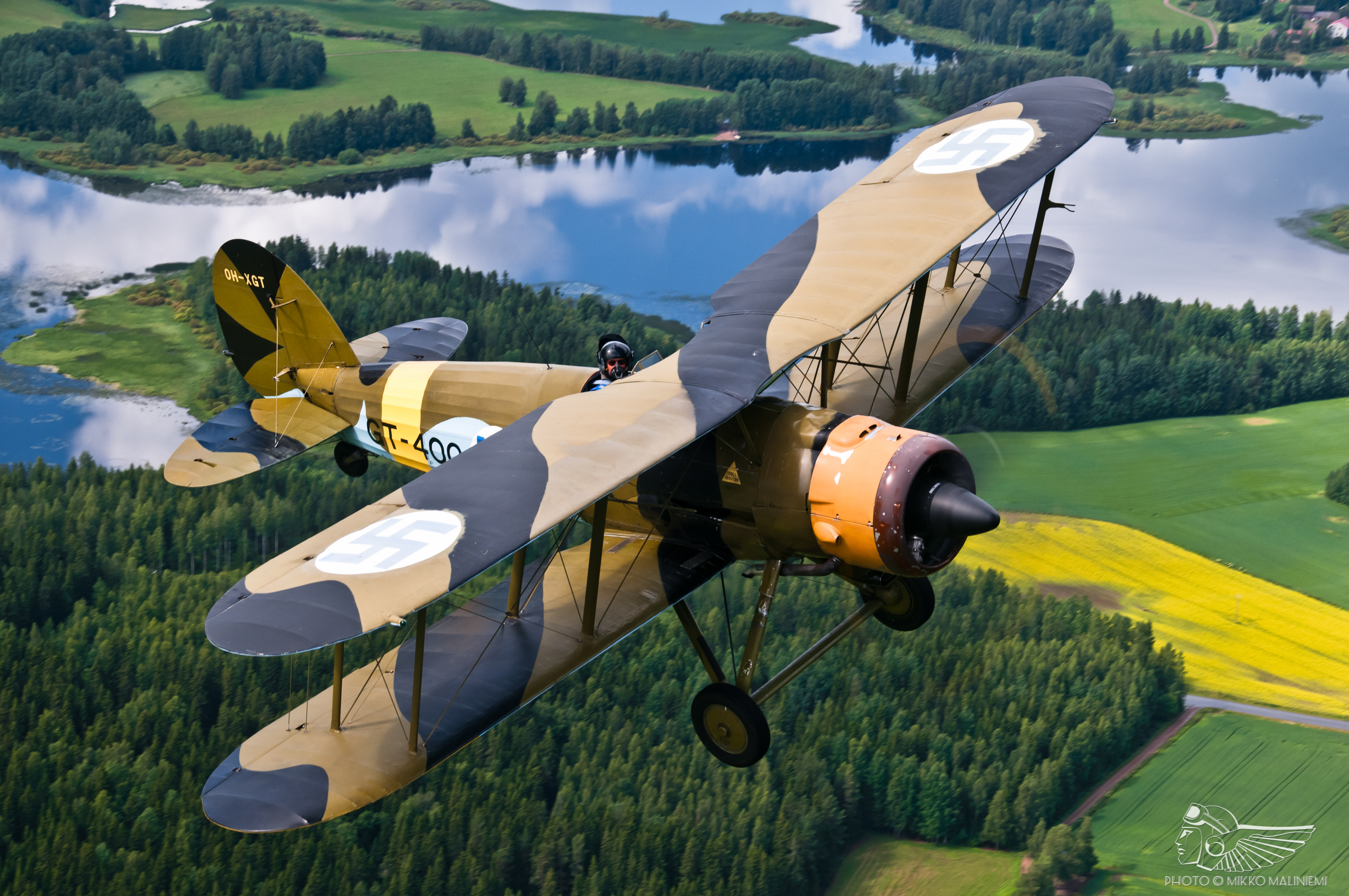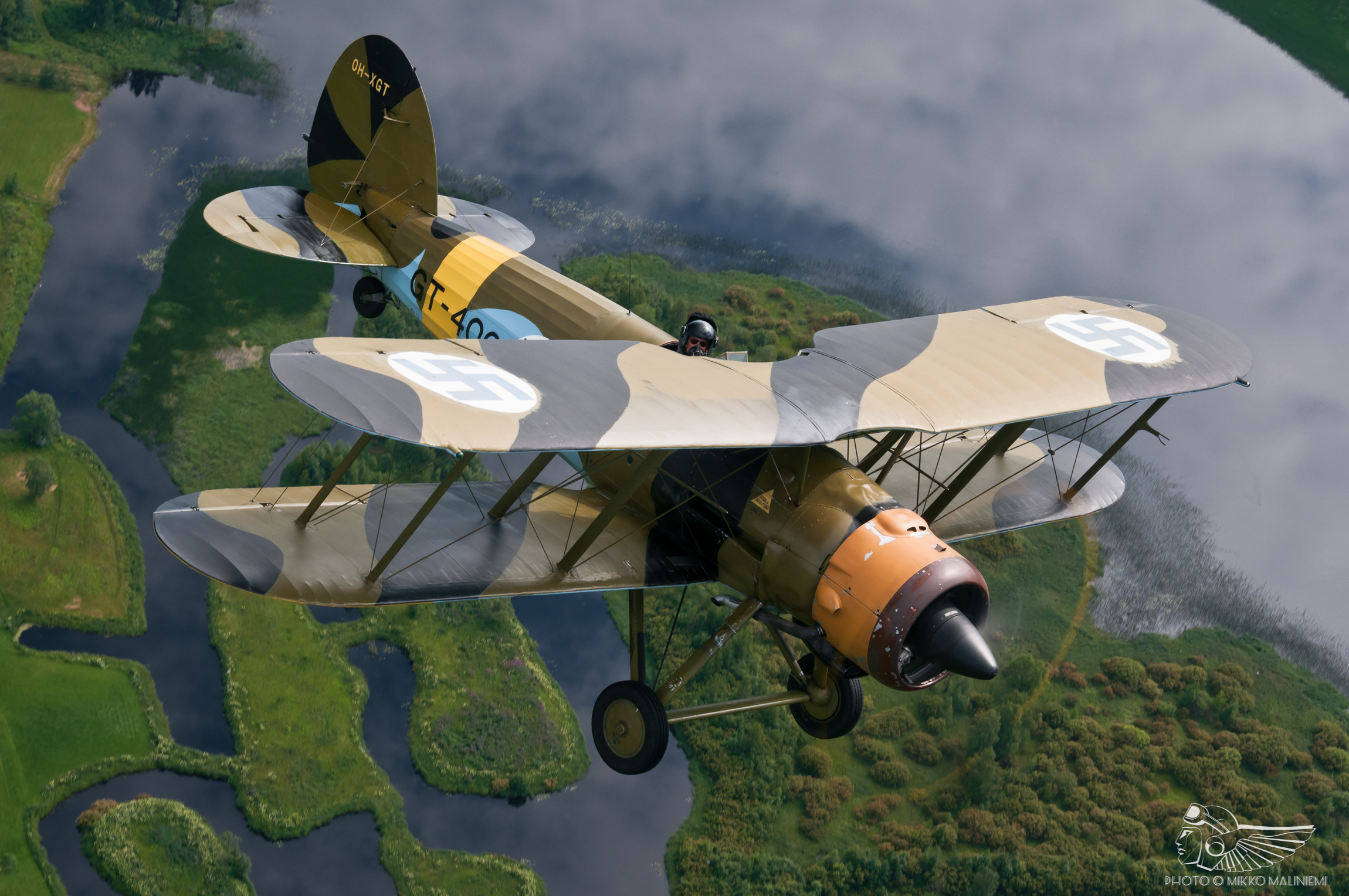I can’t quite put my finger on why I have an almost insatiable appetite for inter-war biplanes. Perhaps it’s the fact that they represent the end of the first era of military aviation when the monoplane began its inexorable conquest as the front line combat design of choice – or maybe my apparently worrying obsession with all things colourful with those flashing silver surfaces bedecked in oh-so bright squadron and national markings.
Perhaps, as I think, it actually stems back to my late father and his similar adoration; I see him now with flying scale models of a Hart and a Fury and his study shelves lined with Airfix Gladiator, Demon and Bulldog and even a rare 1/48 ARII Yokosuka Type 91 amongst others, all the while flicking through pages of books on the subject. Yes, I’ll take the latter, sentimental reason as I still tremble at the sensation of something as familiar as the Gladiator purring around and go all unnecessary when those Kestrels fire up! Scandinavia may at first appear an odd place to be searching for examples of this delightful genre but following my joy at seeing the Hawker Dankok at Stauning, there is another unique machine in Denmark’s most easterly, larger Scandinavian neighbour – and she flies!
Finland post-World War I had emerged as an independent nation but internal unrest and Russian intentions led to a civil war whilst the Molotov-Ribbentrop Pact secretly included Finland as merely an extension of the Russian empire. The November 1939 Soviet attack heralded the start of the Winter War and Finland immediately united to combat the onslaught of its extensive borders. This period of war caught Finland poorly equipped and the Air Force, barely 20 years old, particularly so.
With only some support from its western neighbours the country had to procure any possible aircraft available, resulting in an eclectic mix of multi-national types not seen anywhere else. Many of these aircraft arrived too late to see combat in the Winter War, which ended in March 1940. These included Blenheims, Gladiators, Hurricanes and Lysanders from Britain, Fiat G.50s from Italy and Brewster Buffaloes from the USA. France also donated Morane-Saulnier M.S.406s and South Africa ex-RAF Gloster Gauntlets; these aircraft saw action during the Continuation War from ’41-’44. During this war the western countries were allied with the Soviet Union and no more aircraft were supplied to Finland. In fact, Britain and the USA supplied aircraft to the Soviet Union and these aircraft were used against Finland. Germany, now at war with the Soviet Union, supplied aircraft to Finland; these included war booty Tupolev SB, Ilyushin DB-3, Polikarpov I-153, Pe-2, Morane M.S.406, Curtiss Hawk and original German Do 17Z, Bf 109 G and Ju 88.
The early 1930s saw the Royal Air Force looking for a replacement for its then main fighter, the Bristol Bulldog (it too was operated by the Finns), for such was the pace of aircraft development it had only been in service itself for a couple of years. One of the contenders came from the Gloster stable, its SS.19 prototype becoming the Gauntlet and, following Air Ministry approval, it entered service in 1935 with No. 19 Squadron at Duxford. The Gauntlet proved to be the penultimate biplane and the last open cockpit fighter (the adorable Hawker Fury had beaten it into service by two years) in the RAF – indeed, the end of an era.
So how did the Gauntlet and Finnish Air Force, or “Ilmavoimat”, come to be united, especially given the varying allegiances demonstrated during both wars? As seen above, the Finnish Air Force was in dire need of equipment and any supplier would be welcomed! Finland’s 25 Gauntlet Mk.IIs were ex-RAF and came by way of South Africa, whose No. 2 Squadron was re-equipping with Hurricanes, rendering the Gauntlets surplus to requirements and were gifted to Finland. They arrived in 1940 via the UK and then shipped to Gothenberg, re-assembled at Malmslatt and were given the local name “Kotletti”, bizarrely meaning “Cutlet”. 24 were airworthy and, already more than obsolete, the aircraft were put into service as advanced trainers with units 17, 25, 30, 34 and 35.
Around the same period (and due to the new Allied supply of equipment against the Communist Soviet Union), the Gauntlet’s RAF replacement, the Gladiator, was also entering service as one of many fighter types with the Finns with some success, and Hurricanes too were also Scandinavia bound. They must be made of tough stuff in Finland as the prospect of learning to fly in an open cockpit, un-heated biplane in the country’s perpetual winter dark and arctic temperatures is a little daunting to say the least. To assist in the harsh conditions, many were equipped with skis and some retained armament – the standard 2x 0.303 Brownings put to use during gunnery training. The last flight of a Gauntlet in Finnish service took place on 18 February 1945.
As is so often the case, retired warriors around the globe such as the Gauntlet are put out to grass; scrapped, stored, preserved, cannibalised, sold, but frequently lost to the world. Fortuitously the almost complete remains of two Gauntlets managed to survive on a farm and in the mid-1970s were recovered by personnel of the Air Force Technical Guild (Lentotekniikan Kilta) at Halli Air Base with the intention of restoring a single complete example of the world’s last remaining Gauntlet.
The airframe in question was built for the RAF in 1936 as K5271, and was initially used for trials at Boscombe Down before its roundabout trip to Finland where it was locally numbered GT-400. Finland has a very simple serial system for its military aeroplanes – two letters indicate the aircraft type (GT=GaunTlet, MG=MiG, HN=HorNet, VN=ViNka etc) and then either one or two numbers for trainers/transport types and three for combat types. The aircraft also received period Finnish camouflage of sky blue undersides and green and black-green upper sides with yellow high visibility bands.
A word here also about the Finnish swastika; the national marking for the Ilmavoimat from its creation in 1918 to the end of the war. The second aircraft for the fledgling Air Force was a Thulin donated by the Swedish Count Eric von Rosen whose personal emblem was one he saw in Sweden and adopted for himself. The swastika was an ancient Nordic symbol for sun and good luck and it was applied to the aircraft with a white background and thus adopted by the Air Force on 18 March 1918. Obviously the swastika was used by a certain other regime in 1920 and due to the resemblance to the Nazi version, and the 1944 Allied Control Commission decree prohibiting the existence of pro-Hitler/facism symbology, the Air Force changed to a simple roundel of national colours. No fin flash has ever been worn.
Following a minor landing accident in July 1943, GT-400 was repaired and saw service with a bomber unit as a base hack and liaison machine; it flew until February 1945 and was retired with only 133 hours’ flying time. It took until 1950 for the aircraft to be finally struck off charge and offered for sale, ending up in the aforementioned farm. The rebuild began in earnest in 1976 and such was the enthusiasm, the decision was taken not only to restore a Gauntlet but return it to the air! One major problem to be overcome was a fundamental one – no original Bristol Mercury powerplant could be sourced and it took a fairly revolutionary idea to remedy this. The Alvis Leonides, first bench tested in 1936, taken aloft in a converted Bristol Bulldog and fitted to several ‘40s and ‘50s rugged types such as the Percival Provost and Pembroke/Prince appears a most unlikely candidate to replace the almost dainty Mercury.
Surprisingly however, the Mercury developed 645hp whilst the Leonides only 550hp, and the latter engine drove a three-bladed metal rather than a more in keeping two-blade wooden propeller. A Leonides 503 was taken from a retired Finnish Air Force Pembroke and after much alteration was found to make a usable fit when offered up to the front of the Gauntlet. Apart from the three-blade prop (which had been retrofitted to Finnish Gauntlets in any case), the dimensions of the Alvis engine dictate the retention of the slightly longer, slimmer cowling, air intake scoop and single exhaust stack compared to two on the Mercury. Thus after seven years and 13,000 man hours, GT-400 was re-born almost as it was originally built, albeit with the slightly more modern engine, and was ready for flight in 1982. The next question was, who would fly this precious, unique machine?
Lt Col (Retired) Jyrki Laukkanen is a pilot’s pilot in the true sense. He took up gliding at an early age but due to a slight eye defect he was denied initial selection to become a military pilot and studied to be an aeronautical engineer. Over time the defect righted itself and he progressed through the Finnish pilot training system at Kauhava and became a MiG-21F fighter pilot at Rissala. Given his engineering background Jyrki was offered the chance to become a test pilot, which he accepted with relish and thus sealed his Air Force career path until he retired at the age of 60 (mandatory retirement age) in 2002.
He was based at the Finnish Air Force Test Centre “Koelentue” at Halli and amassed some 9,960 hours on 150 types. He cites himself as the only Finnish pilot to have flown every single MiG-21 to enter Finnish service, having attended ground school in the Cold War-era Soviet Union on the later MiG-21bis version. He also oversaw the evaluation and procurement of the Learjet (having actually preferred the Falcon 20 but budgets denied their purchase) in the USA and the development of such types as the Vinka, Redigo and Hawk. Although a dyed in the wool MiG man he rates the Hawk as the finest aeroplane he has flown – Hawker Siddeley certainly got it just right it would seem, to have the approval of such an esteemed aviator.
His tales of intercepting NATO intruders (RC-135V for instance) and then handing over to Swedish and Soviet fighters followed by having to make an emergency landing due to low fuel, his display flying time and his various excursions worldwide in many different types make for compelling listening. He could have stayed on in the military and risen through the ranks to senior level but this would have been at the cost of him having to fly a desk, something he refused to do!
Due to his involvement with the Gauntlet restoration project, his test pilot and engineering status and his relentless enthusiasm, he was asked to be the pilot to return the Gauntlet to the sky, and this he did on 10 May 1982, with the aircraft being put on the Finnish civil register as OH-XGT. He has maintained his flying time on GT-400, having now already doubled the amount of hours the aircraft flew in original service, as well as his first love – gliders. He is also a stand-by display pilot for the Finnish Historic Flight’s Fouga CM 170 Magister and also performs taxy demonstrations in the Gauntlet’s home museum’s Magister at Kymi.
It would be remiss of me not to mention that apart from his prestigious test pilot career, being the only pilot (following the loss of fellow test pilot Paavo Janhunen in the L-80 TP Turbo-Vinha prototype in 1985) and engineer for the Gauntlet, and the driving force behind the Kymi museum, Jyrki was also the official photographer for the Air Force. Over his career he has taken an incredible 55,000 slides, the majority of which are air-to-airs, compiling an extensive pictorial history of the service from the late 1960s to early 2000s. The fruits of his labour have been born into numerous books covering all facets of Air Force life, packed with some stunning images of a relatively rarely seen air arm.
The Gauntlet, having spent some time at Halli, now resides at Kymi airfield, operated by the flying museum of Karhula Flying Club or “Karhulan Ilmailukerhon Lentomuseo”. Kymi is located some seven miles north of the coastal town and port of Kotka, in the south-eastern corner of the country only some 25 miles or so from the Russian border. For this reason and given its strategic sea faring position, Kotka became a prime target during the Continuation war and so its defence was considered important enough to warrant its own defensive fighter airfield. Kymi was carved out of the seemingly impenetrable conifer and mixed forests that cover some 60% of the country during 1942-3.
The single 1,500 metre gravel runway was used by Fighter Squadron (Havittajalentolaivue) 34’s one flight of some 10-15 Bf 109G-2 and Bf 109G-6 fighters. The squadron, only operating for a little over two years, claimed 345 kills for 30 losses. After no further military use the runway (shortened to 850 metres and paved in the 1970s) and facilities were turned over to civilian use by the Karhula Flying Club, mainly for gliders. The club started a museum in 1992 with several gliders and aforementioned CM 170 Magister FM-43 that is retained in a taxyable condition. A new hangar was built in 1995 and with Jyrki’s influence has built up a wide selection of ex-Finnish warplanes including both “F” and “bis” versions of the MiG-21, Draken and Gnat, trainers such as a Fw 44 Stieglitz and historic gliders that still fly.
And so, all of the above elements came together for me on Friday, 5 June 2015, having found myself in Finland for the Turku airshow over the weekend 6-7 June. The Gauntlet was originally to have attended the show, flying there on the Thursday, however it was withdrawn by the organisers, along with several other acts, to make funds available for the Turkish Stars. Therefore Jyrki very kindly invited me to join him at Kymi for a private viewing of this wonderful aeroplane and tour of the museum.
Waking on a beautiful Summer morning (summer nights in Finland are short – very short – and so morning begins around 3.30am!) I spent some time wildlife spotting before beginning the short drive from Kotka. The approach to Kymi is misleading – a winding narrow road through innumerable trees before reaching a small sign pointing to some old buildings, and then you finally see a clearing and something remotely resembling an airstrip. Driving in, I noted the local flying club were readying their gliders before seeing the target for the day, sitting outside its hangar – Gauntlet GT-400 reflecting the bright early sunshine, which even at 9am is very high in the sky.
After exchanging greetings and pleasantries, Jyrki gives me the bad news that the persistent, strong wind gusting at 25 knots will deny my chance of seeing the aeroplane get airborne. Two factors have combined to spoil my fun – one a result of geography, the other, quite rightly, safety. Kymi’s 16/34 runway was hacked out of the forest in the path of least resistance meaning its NW-SE heading almost perpetually presents crosswind conditions as the prevailing wind is primarily from the south-west.
This presented obvious difficulties for the wartime missions – Bf 109s and their narrow track undercarriage do not take kindly to crosswinds and this led to several mishaps. Wind the clock forward 70-odd years and the same conditions trouble an even more senior aeroplane. Ever mindful of both his own and the Gauntlet’s safety, a statutory 5 knot crosswind limit is placed on the aeroplane, this even more acute due to Kymi’s paved surface, there being no significant flat grassed areas to use as a secondary strip. This dramatically restricts the opportunities available for flight resulting in annual flight times varying from anything as low as four hours to 20.
Weather aside, several other factors limit not only the amount of annual flying but also the very longevity of the Gauntlet’s airborne life. The first is a very obvious one for a machine that requires fuel – Kymi has no fuel supply or storage facilities, therefore Jyrki has to be very sparing with his flights that ultimately end in the aeroplane landing at an airfield with avgas, filling up and returning as economically as possible! If you have the means and you wish to see the Gauntlet fly, don’t take cash or good wishes – take jerry cans of aviation fuel! Unfortunately, the meagre tank of unleaded in my Hyundai hire car didn’t offer much of a top up to the Gauntlet’s tank!
A second very limiting factor to the life of the aircraft is the fact that there is only one propeller available and that is the one currently fitted. If this most essential item is damaged in any way then the Gauntlet won’t fly, unless of course a friendly Leonides owner with unwanted prop could help, perhaps. Finally, Jyrki himself; as the only pilot and engineer, should he become incapable of flying for any reason then the machine becomes a static exhibit only. Fortunately the aviation Gods keep smiling on Kymi and she still graces Finland’s skies. It’s an incredible story of tenacity and skill that the Gauntlet remains airworthy with such limited resources. The aeroplane has no planned or “minor/major” service programmes, or sponsored support – relying completely on the Kymi team to perform all of the checks and maintenance in-house.
And so back to my visit – following my initial disappointment I was lifted somewhat by Jyrki offering to ground run the Gauntlet as the old girl needed to stretch her legs and those 550 horses needed some lubrication. After a quick briefing asking what I wanted him to do, Jyrki fired up the willing radial with the ubiquitous and copious cloud of rich blue smoke and headed for a small hardstanding. For the next ten minutes or so the aircraft was presented to me in every possible angle given the limitations of it being on the ground, aided by Jyrki’s own photographic knowledge to make use of the best light. Conscious however of my rapidly swelling buffer and that Leonides drinking precious fuel and oil, I reluctantly signalled thumbs up and cut throat to end this most enjoyable session and the aircraft was taxied back to the museum hangar.
Jyrki did comment that the strong wind was making even taxying the biplane difficult, and so the justification for not flying was even more relevant. After some inevitable posed ‘selfies’ we pushed the Gauntlet back into the dark but protective confines of the museum hangar, its wonderful, living presence that you can almost taste making it stand out from its static, lifeless fellow inmates. Long may it stay that way!
As a post script, though the transit distances are too great, Jyrki is not averse to the idea of shipping the Gauntlet to (say) the UK and flying it for a season away from its Scandinavian home. Obviously the cost would be significant but just think of the sight and sound of a Gauntlet with two Gladiators leading up to five Hawker biplanes around the summer skies! This leads me nicely to my conclusion – very much where I began this report; my passion for inter war biplanes and the fact that so many are not only extant, but, thanks to some incredibly talented, resourceful and enthusiastic individuals, very much alive and kicking!
With very many grateful thanks to Jyrki Laukkanen, his colleagues at Kymi museum and a fabulous biplane.
![]()


